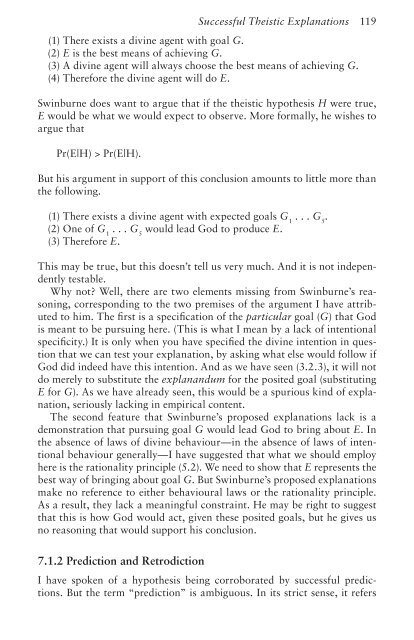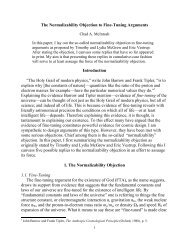Theism and Explanation - Appeared-to-Blogly
Theism and Explanation - Appeared-to-Blogly
Theism and Explanation - Appeared-to-Blogly
You also want an ePaper? Increase the reach of your titles
YUMPU automatically turns print PDFs into web optimized ePapers that Google loves.
Successful Theistic <strong>Explanation</strong>s 119<br />
(1) There exists a divine agent with goal G.<br />
(2) E is the best means of achieving G.<br />
(3) A divine agent will always choose the best means of achieving G.<br />
(4) Therefore the divine agent will do E.<br />
Swinburne does want <strong>to</strong> argue that if the theistic hypothesis H were true,<br />
E would be what we would expect <strong>to</strong> observe. More formally, he wishes <strong>to</strong><br />
argue that<br />
Pr(E|H) > Pr(E|H).<br />
But his argument in support of this conclusion amounts <strong>to</strong> little more than<br />
the following.<br />
(1) There exists a divine agent with expected goals G 1 . . . G 5 .<br />
(2) One of G 1 . . . G 5 would lead God <strong>to</strong> produce E.<br />
(3) Therefore E.<br />
This may be true, but this doesn’t tell us very much. And it is not independently<br />
testable.<br />
Why not? Well, there are two elements missing from Swinburne’s reasoning,<br />
corresponding <strong>to</strong> the two premises of the argument I have attributed<br />
<strong>to</strong> him. The fi rst is a specifi cation of the particular goal (G) that God<br />
is meant <strong>to</strong> be pursuing here. (This is what I mean by a lack of intentional<br />
specifi city.) It is only when you have specifi ed the divine intention in question<br />
that we can test your explanation, by asking what else would follow if<br />
God did indeed have this intention. And as we have seen (3.2.3), it will not<br />
do merely <strong>to</strong> substitute the explan<strong>and</strong>um for the posited goal (substituting<br />
E for G). As we have already seen, this would be a spurious kind of explanation,<br />
seriously lacking in empirical content.<br />
The second feature that Swinburne’s proposed explanations lack is a<br />
demonstration that pursuing goal G would lead God <strong>to</strong> bring about E. In<br />
the absence of laws of divine behaviour—in the absence of laws of intentional<br />
behaviour generally—I have suggested that what we should employ<br />
here is the rationality principle (5.2). We need <strong>to</strong> show that E represents the<br />
best way of bringing about goal G. But Swinburne’s proposed explanations<br />
make no reference <strong>to</strong> either behavioural laws or the rationality principle.<br />
As a result, they lack a meaningful constraint. He may be right <strong>to</strong> suggest<br />
that this is how God would act, given these posited goals, but he gives us<br />
no reasoning that would support his conclusion.<br />
7.1.2 Prediction <strong>and</strong> Retrodiction<br />
I have spoken of a hypothesis being corroborated by successful predictions.<br />
But the term “prediction” is ambiguous. In its strict sense, it refers



